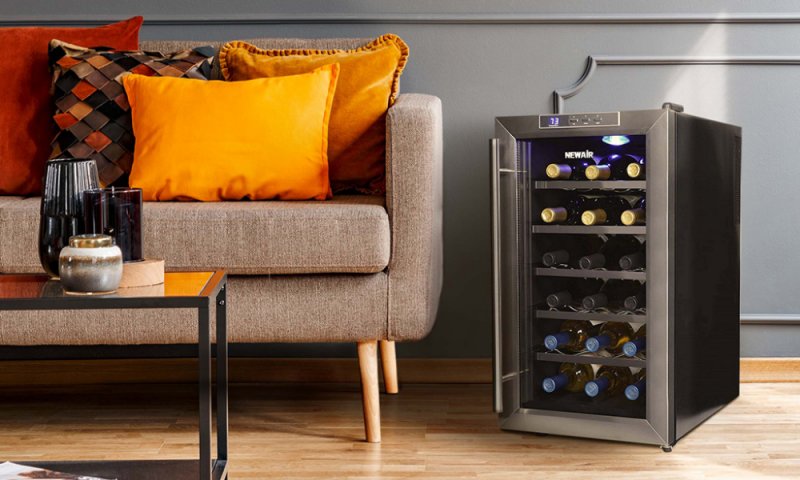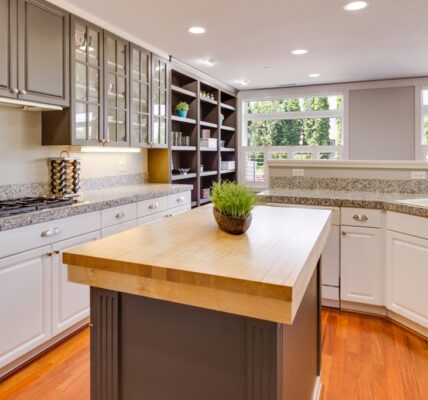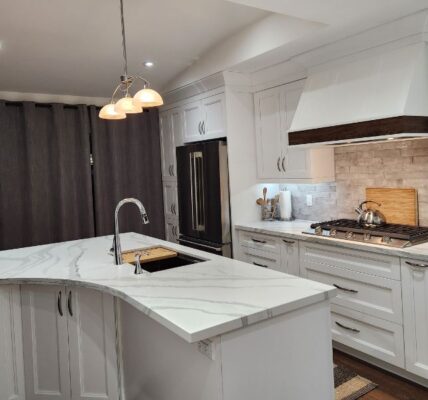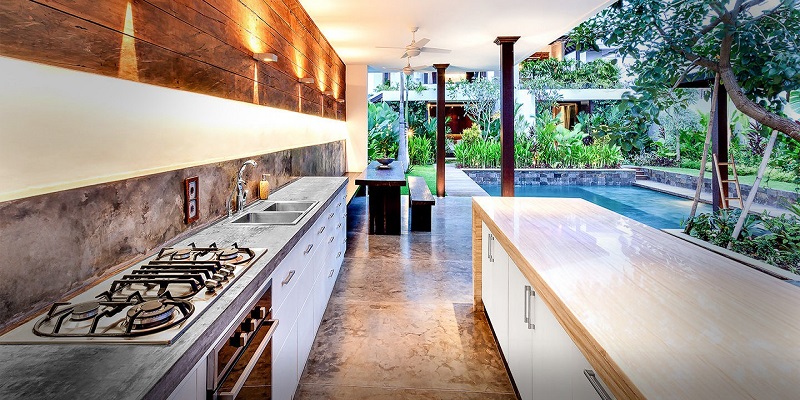Your worktop is not just a place to prepare food, but also a key part of your kitchen’s look and feel. With so many options available, it can be hard to know where to start. This article will guide you through understanding your needs, exploring different materials, budgeting, installation, design choices, special features, and maximizing your kitchen space.
Allways visit a kitchen showroom to see samples in person and get a feel for how each material looks and feels. Don’t hesitate to ask for expert advice to help you make the best choice for your home.
Key Takeaways
- Consider your cooking habits, family size, and lifestyle when choosing a worktop.
- Different materials like granite, quartz, wood, and laminate have unique pros and cons.
- Set a realistic budget and compare the costs of various materials before making a decision.
- Think about whether you will install the worktop yourself or hire a professional.
- Choose colors and textures that complement your kitchen cabinets and overall design.
Understanding Your Kitchen Needs
Choosing the right worktop for your kitchen starts with understanding your specific needs. This involves looking at how you use your kitchen, the size of your family, and how much maintenance you’re willing to do. Let’s break it down further.
Assessing Your Cooking Habits
Think about how you use your kitchen daily. Do you cook elaborate meals or stick to simple dishes? Your cooking habits will influence the type of worktop you need. For example, if you love baking, you might prefer a surface that’s easy to clean and resistant to stains.
Considering Family Size and Lifestyle
The size of your family and your lifestyle play a big role in choosing a worktop. A larger family might need a more durable and spacious worktop. If you have young kids, you might want a surface that’s easy to clean and resistant to scratches.
Evaluating Maintenance Preferences
Different worktop materials require different levels of care. Some need regular sealing, while others are low-maintenance. Think about how much time you’re willing to spend on upkeep. If you prefer a low-maintenance option, materials like quartz or laminate might be ideal.
By understanding your kitchen needs, you can make a more informed decision when choosing a worktop. This ensures that your kitchen is not only stylish but also functional and suited to your lifestyle.
Exploring Worktop Materials
Choosing the right worktop material is crucial for both functionality and style in your kitchen. Let’s dive into some popular options and their unique benefits.
Granite: Pros and Cons
Granite is a natural stone that offers a bold and luxurious look. It’s highly durable and heat-resistant, making it perfect for avid cooks. However, it can be expensive and requires regular sealing to prevent stains.
Quartz: Durability and Style
Quartz worktops are engineered from natural quartz and resin, providing a non-porous and low-maintenance surface. They come in a variety of colors and patterns, making them a versatile choice for any kitchen design. Quartz is also known for its exceptional durability.
Wood: Natural Beauty and Care
Wooden worktops bring a warm and natural feel to your kitchen. They are ideal for those who love a rustic or traditional look. However, wood requires regular maintenance, such as oiling, to keep it in good condition. It’s also prone to scratches and stains, so care is needed.
Laminate: Budget-Friendly Options
Laminate worktops are a cost-effective choice that offers a wide range of designs, including those that mimic more expensive materials like granite and wood. They are easy to clean and maintain, making them a practical option for busy families. Laminate is also resistant to heat, scratches, and stains, providing a durable surface for everyday use.
Budgeting for Your Worktop
Setting a Realistic Budget
Before you start planning your dream kitchen, it’s really important to know where to start. Determine your budget before diving into the selection process. Worktops can range from affordable laminates to high-end granite or quartz. Knowing your budget helps you narrow down your choices and ensures you spend wisely.
Comparing Costs of Different Materials
Here’s a quick comparison of different worktop materials and their costs:
| Material | Cost Range (per sq. meter) |
| Laminate | £50 – £100 |
| Wood | £120 – £200 |
| Quartz | £200 – £400 |
| Granite | £250 – £500 |
Each material has its own pros and cons, so consider what fits best with your kitchen needs and lifestyle.
Long-Term Investment vs. Short-Term Savings
When choosing a worktop, think about whether you want a long-term investment or short-term savings. High-quality materials like granite and quartz are more expensive but last longer and add value to your home. On the other hand, budget-friendly options like laminate can save you money upfront but may need replacing sooner.
Balancing your budget with your kitchen needs will help you make the best choice for your worktop. Consider both the initial cost and the long-term benefits to find the perfect fit for your kitchen.
Installation Considerations
DIY vs. Professional Installation
When choosing your worktop, think about the installation process. Some materials are easy for homeowners to install, while others need a professional touch. Professional installation can add to the overall cost, but it ensures a perfect fit and finish.
Time Required for Installation
The time it takes to install a worktop can vary. Simple materials like laminate can be installed quickly, while more complex materials like granite might take longer. Make sure you have enough time set aside for the installation process.
Potential Challenges and Solutions
Installing a worktop can come with challenges. For example, cutting grooves for sinks or hobs can be tricky. If you’re doing it yourself, be prepared for these tasks. If you’re hiring a professional, discuss these potential issues beforehand to avoid surprises.
Remember, the installation process can affect the overall cost and timeline of your kitchen project. Plan accordingly to ensure a smooth installation experience.
Design and Aesthetic Choices
Choosing Colors and Textures
When selecting a worktop, choosing the right colors and textures is crucial. Your worktop should complement the overall design of your kitchen. Consider whether you want a bold statement piece or something that blends seamlessly with your cabinets and appliances.
Matching Worktops with Cabinets
Matching your worktop with your cabinets can create a cohesive look. You can either match the colors closely or choose contrasting shades for a more dynamic appearance. Think about the style of your kitchen—modern, traditional, or rustic—and pick materials that enhance that theme.
Exploring Edge Profiles
The edge profile of your worktop can add a subtle yet significant touch to your kitchen’s design. Options range from simple, straight edges to more intricate designs like beveled or bullnose edges. Each profile offers a different aesthetic and can impact the overall feel of your kitchen.
When you explore a variety of kitchen worktop ideas, you’ll find that the edge profile can make a big difference in the final look of your kitchen. Choose wisely to match your style and needs.
Special Features and Functionalities
Heat Resistance
When choosing a worktop, heat resistance is crucial. Some materials, like granite and quartz, can withstand high temperatures, making them ideal for busy kitchens. Always consider how much heat your worktop will need to handle.
Scratch and Stain Resistance
For a kitchen that sees a lot of action, scratch and stain resistance is a must. Quartz is incredibly durable and resistant to scratches and stains, making it an excellent choice for busy kitchens. It’s also non-porous, which means it won’t absorb spills and stains easily.
Eco-Friendly Options
If you’re environmentally conscious, look for eco-friendly worktop options. Materials like bamboo and recycled glass are sustainable choices that don’t compromise on style or durability. These options help reduce your carbon footprint while still providing a beautiful and functional kitchen surface.
Maximizing Space and Layout
Measuring Your Kitchen Space
Before choosing a worktop, it’s essential to measure your kitchen space accurately. Start by measuring the length and width of your kitchen. Don’t forget to account for any fixtures or appliances that might affect the available space. Accurate measurements ensure that your worktop fits perfectly and maximizes your kitchen’s functionality.
Choosing Worktops for Different Layouts
Different kitchen layouts require different worktop solutions. Here are some common layouts and tips for each:
- Galley Kitchens: Use long, continuous worktops to create a seamless look.
- L-Shaped Kitchens: Opt for corner worktops to utilize space efficiently.
- U-Shaped Kitchens: Consider sectional worktops to make the most of the available area.
Seamless vs. Sectional Worktops
When deciding between seamless and sectional worktops, consider your kitchen’s design and your personal preferences. Seamless worktops offer a sleek, modern look and are easier to clean. On the other hand, sectional worktops can be more flexible and easier to install, especially in kitchens with unusual shapes or sizes.
Expert advice on choosing small kitchen layouts can help boost the look and feel of space in even the most bijou of rooms – from galleys to L-shapes.
Conclusion
Choosing the right worktop for your kitchen is a big decision, but it doesn’t have to be overwhelming. By considering your budget, the time you have for installation, and whether you’ll need professional help, you can narrow down your options. Think about how you’ll use the worktop, like if you need it to be heat-resistant or easy to clean. Measure your space carefully to avoid any surprises. Finally, pick a color and texture that matches your style. With these steps, you’ll find a worktop that not only looks great but also fits your needs perfectly.
Frequently Asked Questions
How do I determine the best worktop for my kitchen?
Start by asking yourself some key questions: What is your budget? How much time do you have for installation? Are you planning to hire a professional or do it yourself? Do you need a heat-resistant worktop? How diligent are you with cleaning spills? How much space do you have for the worktop? What color and texture do you prefer?
What are the pros and cons of granite worktops?
Granite worktops are very durable and have a unique, high-end look. They can add value to your home. However, they are expensive, can be difficult to repair, and require yearly sealing to maintain their stain resistance.
Is laminate a good choice for a budget-friendly worktop?
Yes, laminate worktops are one of the most budget-friendly options available. They are easy to install, come in various designs, and are low maintenance. However, they can be prone to damage from cuts and high heat.
Should I hire a professional for worktop installation or can I do it myself?
It depends on your skill level and the type of worktop you choose. Some materials, like laminate, are easier to install yourself. Others, like granite or quartz, are heavier and more complicated, making professional installation a better option.
What factors should I consider when choosing a worktop material?
Consider your cooking habits, family size, and lifestyle. Think about how much maintenance you are willing to do. Also, consider the durability, heat resistance, and scratch resistance of the material. Finally, think about your budget and the overall look you want for your kitchen.
How do I maintain and care for different types of worktops?
Maintenance varies by material. Granite needs yearly sealing, wood needs regular oiling, and laminate just needs a simple wipe down. Always follow the manufacturer’s care instructions to keep your worktop in the best condition.
Keep an eye for more latest news & updates on Kitchen Outlook!





